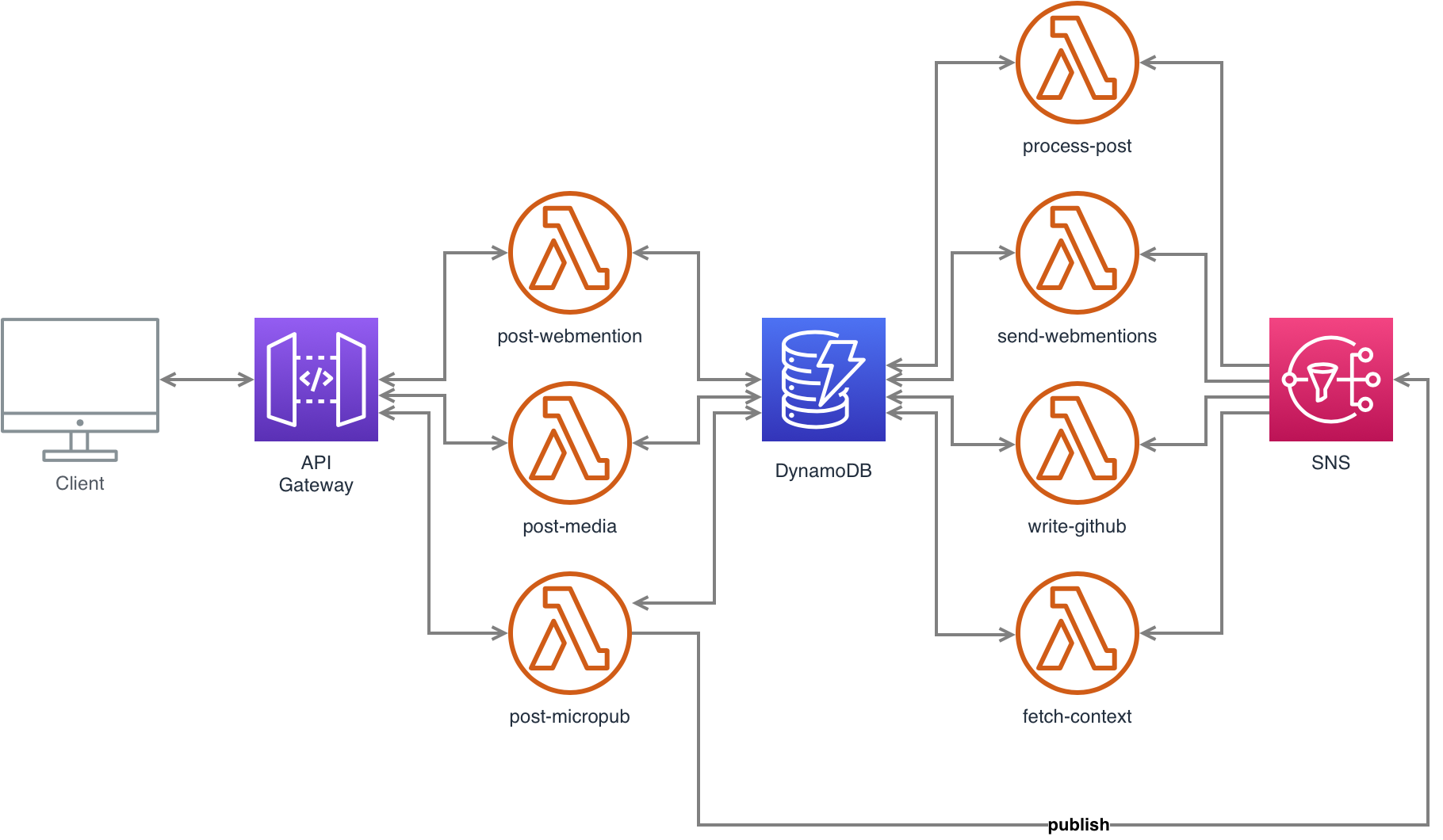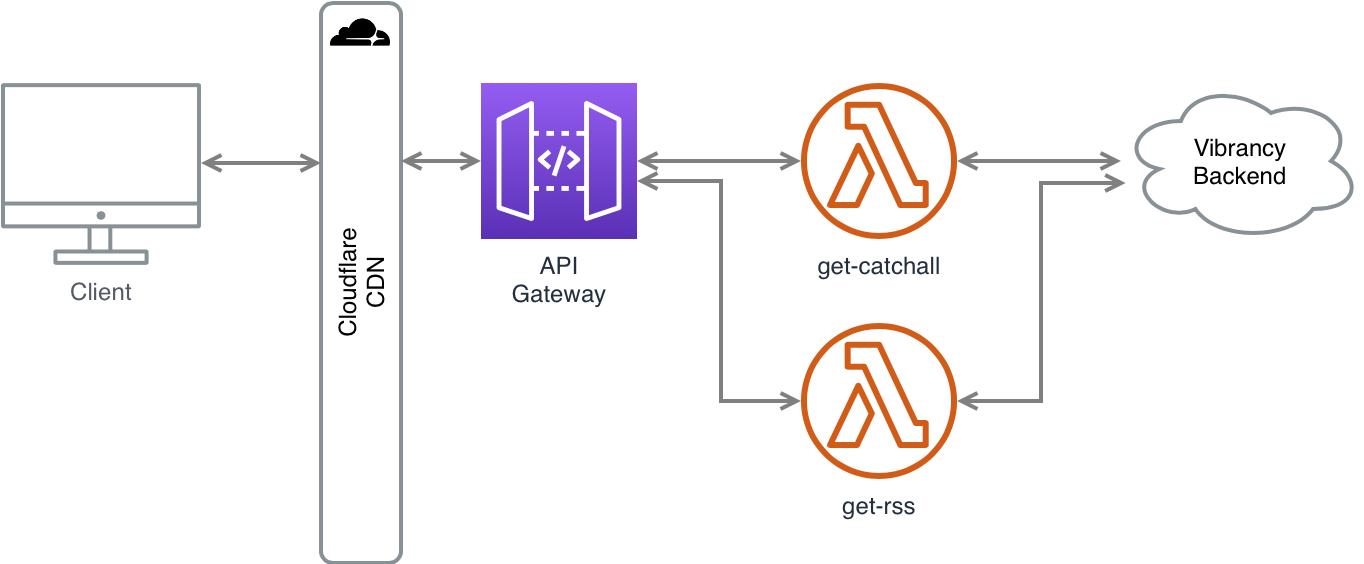My serverless, headless, Micropub-powered, personal website
TL;DR This is my new personal IndieWeb website built using serverless AWS services, written in Node.js with the Architect framework. The backend is a Micropub server with a separate frontend that fetches posts using Micropub queries, rendering pages behind a CDN.
Look, I know it’s a developer cliché for the majority of posts on your blog to be about rewriting your own personal website software, but I find my website is the perfect place to try out new technology and then document what I’ve learned.
So, yes, this is a blog post about my new website. As well as a refreshed design, it’s completely different behind the scenes. The project is called Vibrancy. It’s massively over-engineered! But that’s the point: learn, have fun and enjoy slowly hacking away after the kids go to bed.
Goals
- Instant updates. My website has over 10K posts and even the fastest static site generators take ~10 seconds to build and deploy so many files. I want the time between hitting create/update and the page refreshing to be instant.
- Save money. My previous, low-traffic website cost $16/month on Heroku for a Hobby tier dyno, plus a PostgreSQL database with over 10K rows. I love Heroku, but that’s a bit much for my little website. I wanted my website to cost a few dollars on AWS, after the always free limits.
- Use new (to me) technology:
- Serverless: My website doesn’t get much traffic and having an always-on server seemed wasteful. It seemed like a good use-case for trying small, stateless Node.js functions that can be called on-demand without reserving compute.
- AWS: While I’d used EC2 and S3 before, I wanted to experiment with other AWS services like Lambda, API Gateway, DynamoDB, SNS and CloudWatch that complement a serverless approach.
- Node.js: Ruby is a comfortable pair of shoes. I used it for previous versions of this website and it felt like time for a change. Node.js is a well-supported choice for Serverless.
Framework
I’m using Architect for both the backend and frontend apps. I spent some time prototyping with the Serverless Framework, but was left frustrated at its incomplete support for local development. This is where Architect shines:
Architect is an opinionated developer experience (DX) for building database backed web apps with AWS. We remove all the noise and friction to building serverlessly. We prioritize speed with fast local dev, smart configurable defaults and flexible Infrastructure as Code.
At its core is the app.arc manifest file and a file structure based around primitives for HTTP requests, events, queues, scheduled tasks, tables, static files and more. Each maps to an AWS service, for example tables corresponds to DynamoDB tables and queues to SQS. Architect then provides helpers to simplify working with each service. And by running arc deploy, it builds a SAM application that is magically deployed via CloudFormation to AWS.
Architect has been a breath of fresh air and reminds me of how natural Rails felt the first time I tried it. It deserves a proper article.
Backend

Vibrancy’s backend architecture, hosted using AWS.
Headless CMS
I like the concept of separating the management of my content from its display by adopting a headless CMS architecture. In theory, I‘m free to build multiple frontends that all use the same backend. There are plenty of excellent headless CMS options, but I built my own. Why? Well, I wanted to embrace the constraints of managing content exclusively via Micropub.
By implementing the Micropub server specification, Vibrancy has a mature, well-documented API for creating, updating, deleting, reading and querying posts. There is no admin system. Instead, using a Micropub client like Micropublish or Quill, I can log in (via IndieAuth) and manage my content.
Media endpoint
Vibrancy offers a Micropub media endpoint: a method to upload images and get a URL for use in posts. Cloudinary is used to upload, store and serve photos. Its ability to dynamically-resize images means I can upload one large file and then request different sizes on the fly, keeping frontend page sizes down. Images are then also uploaded to GitHub.
Background events
Using Architect’s event handlers, the server fires off asynchronous tasks in the background to avoid blocking page requests. Lambda functions are handled using SNS.
- Syndication: if specified when I create a post, the backend will POSSE notes to Twitter and bookmarks to Pinboard.
- Webmentions: when a post is created or updated, the server will send webmentions to any links using Telegraph.
- Backup: all posts, webmentions and photos are also stored in a private git repo on GitHub.
- Contexts: to display a snippet of the source of any bookmarks, RSVPs, replies, reposts or likes, the server uses Granary to fetch structured data in Microformats format and falls back to Open Graph metadata.
- Push: the server uses Pushover to send me a push notification whenever a webmention is received.
Storage
- DynamoDB: Content is indexed and stored in AWS’s DynamoDB. It’s a fast, low-latency database and its
tablesare a core primitive in Architect. I’m reasonably happy with it, but found the need to create extra tables a bit dirty when trying to combine filters with pagination. It was worth embracing its differences and learn its constraints to follow the Architect happy path. - GitHub: Content is also stored in a git repository on GitHub as a backup. If needed, I could regenerate the DynamoDB database from the repo. I’ve chosen to make the repo private because it’s possible some posts may be private or start off as drafts.
- Cloudinary: As described above, photos are stored in Cloudinary and served from its CDN.
Frontend

Vibrancy’s frontend architecture, hosted using AWS and Cloudflare.
Micropub queries
The frontend website doesn’t have a database or any content files of its own. Instead, when a post is requested, a Micropub source query is made to the backend and the post is returned in Microformats 2 JSON format.
// Request for https://barryfrost.com/2021/07/a-post
GET https://api.barryfrost.com/micropub?q=source&url=https://barryfrost.com/2021/07/a-post
{
"type": [
"h-entry"
],
"properties": {
"published": [
"2021-07-01T12:34:56Z"
],
"content": [
"This is my post. I use *Markdown* to mark up text."
]
}
}
The frontend takes this JSON object and renders a page using Nunjucks templates. It also converts Markdown to HTML if needed.
Lists of posts are also fetched in the same way, but with additional parameters to filter results:
beforetakes an integer representing the epoch time of a post’s published timestamp. This method is used to paginate results.limitis the number of posts to return in the response, defaulted to 20.
Like the backend, the frontend uses the Architect framework.
Style
This is the first project on which I’ve used Tailwind CSS. Initially it felt like heresy, but I quickly began to enjoy how fast it was to build solid, responsive layouts without needing to bounce back-and-forth between HTML and CSS files. Tailwind also provides a built-in dark mode with very little configuration.
I’m using inline SVGs for icons instead of an icon font to help further decrease page load times.
CDN
The frontend is not static. It queries and renders pages on demand. However, posts are cached and served using Cloudflare’s CDN (Content Delivery Network). I use very long s-maxage cache headers for posts which mean that requests are less likely to hit the frontend. If a post is updated Vibrancy sends a flush API request to Cloudflare.
Webmentions
Vibrancy fully supports webmentions for replies, reposts, likes or mentions from another IndieWeb website or service.
- Receiving: Vibrancy currently uses webmention.io to receive webmentions, accepting a Microformats payload using a webhook. Next on my list is building my own receiver.
- Sending: Webmentions are sent via Telegraph using a background event whenever a post is created or updated.
- Backfeed: Using the magic of Bridgy, responses to my syndicated copies (e.g. tweets) are pulled back as webmentions.
Open source
Vibrancy’s source code is available on GitHub for both the backend and frontend using the MIT licence. Feel free to poke around, but I’m still actively developing and improving it and I wouldn’t recommend using Vibrancy for your own site just yet.
COMMENTS 12
-
-
This is a nice read! What do you think about vendor lock-in (everything is based on AWS and a few other proprietary services) and how much does it cost you per month (is it cheaper than your previous Heroku setup)?
-
Thanks, Jan-Lukas. I’m pretty happy with AWS and I don’t think I would want to switch away. It’s more likely I will rewrite again someday! Thinking of AWS as a framework itself resonates with me. In terms of costs, outside the generous “always free” Lambda and SNS limits, I’m currently paying about $1/month for API Gateway and DynamoDB usage.
-
-
This is an interesting read, it gave me a lot of ideas for how I might self-host the parts of my website which currently use third-party services. I might play with Architect when I get a chance.
-
Thanks very much, Rowan. Let me know if you’ve any questions about it. Architect is definitely worth having a poke around.
-
@brianleroux If you and @filmaj are interested in this stuff you could have a poke around my Architect-powered IndieWeb backend and website. https://github.com/barryf/vibrancy https://barryfrost.com/2021/07/vibrancy
-
-
-
will do, should have an alpha ready indieauth plugin this week 👍 looking at pub/sub/mention next
-
Excited to see it. Architect is the perfect framework for these type of services (as you know!)
-